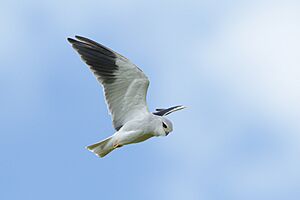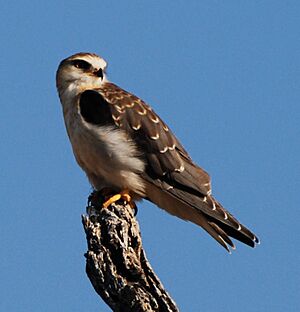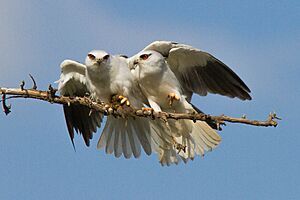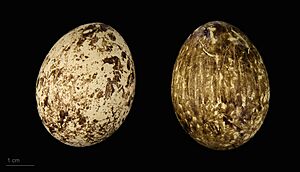Black-winged kite facts for kids
Quick facts for kids Black-winged kite |
|
|---|---|
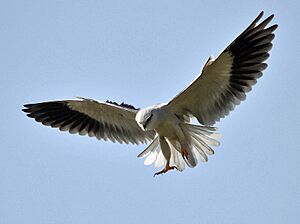 |
|
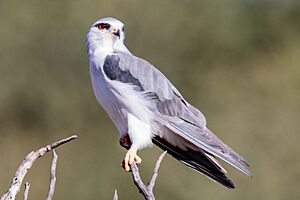 |
|
| E. c. caeruleus hovering and perched | |
| Conservation status | |
| Scientific classification | |
| Genus: |
Elanus
|
| Species: |
caeruleus
|
| Subspecies | |
|
|
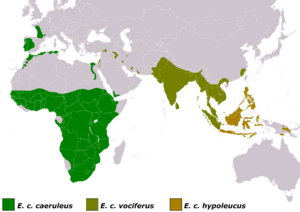 |
|
| Range of E. caeruleus | |
| Synonyms | |
|
|
The black-winged kite (Elanus caeruleus), also known as the black-shouldered kite, is a small bird of prey. These birds are active during the day. They belong to the Accipitridae family, which includes eagles and hawks. Black-winged kites are famous for hovering over open fields. They do this just like smaller kestrels.
You can find this bird in parts of Europe, Africa, and Asia. Sometimes, people used to group it with the Australian black-shouldered kite and the white-tailed kite from America. These three birds are very similar. The black-winged kite looks special with its long wings. It has white, grey, and black feathers. Its eyes face forward like an owl's and have red centers.
Even though they look like owls, black-winged kites are active in the daytime. They mostly live in flat grasslands. But sometimes, you can see them on grassy hills in Asia. These kites do not migrate long distances. Instead, they move around to find food and good weather. They are very good at finding places where there are lots of rodents. This means they can have many baby birds in one year. This is different from most birds of prey. In southern Europe, their numbers have grown. This is because of farming and raising animals.
Contents
Understanding the Black-winged Kite's Name
The black-winged kite was first described in 1789. A French scientist named René Louiche Desfontaines gave it the name Falco caeruleus. Today, it is part of the Elanus group of birds. This group was named in 1809 by another French scientist, Jules-César Savigny.
The word Elanus comes from an old Greek word. It means "kite." The word caeruleus is Latin for "blue." So, its scientific name means "blue kite."
Different Types of Black-winged Kites
There are three main types, or subspecies, of the black-winged kite:
- E. c. caeruleus: This type lives in Spain, Africa, and parts of Arabia.
- E. c. vociferus: You can find this type from Pakistan to eastern China. It also lives in Malaysia and Indochina.
- E. c. hypoleucus: This type lives on islands like Sumatra, Java, and the Philippines.
What Does a Black-winged Kite Look Like?
This bird has long wings and is mostly grey or white. It has black patches on its shoulders and wing tips. It also has a black stripe near its eyes. When the bird is sitting, its long, falcon-like wings go past its tail.
When it flies, you can see its short, square tail. It is not forked like the tails of other kites. When a black-winged kite sits, often on power lines, it moves its wings and tail up and down. This helps it balance. Male and female kites look the same.
Their large eyes face forward, like an owl's. They are set under a bony ridge that shades them. Their soft feathers and special feet are also like an owl's. Scientists think these birds are good at living in grasslands. This is where rodent numbers can go up and down. Owls also like to hunt rodents.
Where Black-winged Kites Live
The black-winged kite mostly lives in open areas and dry lands. You can find them in Africa south of the Sahara desert. They also live in tropical parts of Asia. In Europe, they are found in Spain and Portugal.
Their range seems to be growing in southern Europe and West Asia. They first started breeding in Europe in the 1860s. Since then, they have spread more widely. Their numbers are increasing. People think changes in how land is used, like more farming, have helped them.
Different groups of black-winged kites live in different places. The main type lives in Spain, Africa, and Arabia. The vociferus type lives across South Asia and Southeast Asia. The hypoleucus type lives on islands like Sumatra and the Philippines.
Even though they mostly live in flat areas, they have been seen in high mountains. This includes places in Sikkim (about 3,650 meters high) and the Nilgiris (about 2,670 meters high).
How Black-winged Kites Live and Behave
Black-winged kites can breed at different times of the year. In India, they nest almost all year. Males choose and protect their territories. Females then join the males in these areas. When a pair forms, they often mate.
Their nest is a loose platform made of twigs. They usually lay 3 or 4 eggs. The eggs are pale cream with red spots. Both parents help hatch the eggs. Once the chicks hatch, the male bird hunts more for food. The female feeds the young birds at first. She might hunt nearby or get food from the male.
After the young birds learn to fly, they still need food from the male for about 80 days. Young birds have reddish-brown feathers. This color helps them hide. After breeding, females often move to new areas. They sometimes leave the male to raise the young alone. Both male and female kites move around a lot.
Unlike most birds of prey, they can have many groups of babies in one year. Young birds also travel far. This helps them use times when there are many rodents.
Hunting and Food
Black-winged kites eat many things. Their diet includes grasshoppers, crickets, and other large insects. They also eat lizards and rodents. Sometimes, they catch injured birds, small snakes, and frogs.
The black-winged kite flies slowly when hunting, like a harrier. But it can also hover in the air, like a kestrel. Sometimes, they even catch prey while flying. They often hunt from a perch, like a tree branch or wire. They also eat their prey while perched. But if the prey is large, they might eat it on the ground. In southern Africa, they like to hunt along roadsides. Sadly, this means they can sometimes get hit by cars.
Sounds and Roosting
These birds gather in groups to sleep. About 15 to 35 kites (even more in Europe) will meet in a large, leafy tree. They are usually very quiet. Their calls include a high-pitched squeal or a soft whistle. They mostly call during breeding season or at their sleeping spots.
Other sources




